While Israel’s adversaries have always charged the country with many misdeeds, only relatively recently have these alleged transgressions coalesced into the so-called BDS movement (Boycott, Divestment and Sanctions), modeled after the campaign against apartheid South Africa, and based on the allegation that Israel too is an apartheid state. An integral part of the BDS campaign is Israeli Apartheid Week on some college campuses, featuring speakers, demonstrations and street theater meant to illustrate the claim that Israel is, simply put, bad. So bad that, like apartheid South Africa, it is illegitimate and should cease to exist.
When examined in detail, however, the apartheid charges fall apart, since Israel is, in fact, a progressive and liberal democracy. Like other western democracies Israel is imperfect, but when mistakes and injustices occur they are usually, in the end, rectified thanks to the country’s extensive checks and balances. Unlike neighboring Arab countries Israel has free elections, a free press, full religious freedom, and full rights for women and minorities, including gays. In Israel there are Arab legislators in the Knesset, Arab diplomats in the Foreign Ministry, Arab generals in the Israel Defense Forces, and also Arab judges. In fact, it was an Arab District Court judge (George Karra) who recently sentenced former Israeli President Moshe Katzav to jail, and an Arab Supreme Court Justice who upheld the sentence (Salim Joubran).
As with many anti-Israel sites, the ones focusing on alleged Israeli apartheid often include embarrassing quotations attributed to Israeli leaders, to make them seem like racist, bloodthirsty killers of innocent Arab women and children. Tracing these quotations to their sources shows that most are simply made up, while others are wrenched out of context.
And while it’s true that Palestinians in Gaza and the West Bank who lived under Israeli rule didn’t have the same rights as Arabs or Jews in Israel, they also didn’t experience anything at all comparable to apartheid. In fact, in many ways they had more rights under Israeli rule than they have today under Hamas rule in Gaza, or under PA rule in the West Bank, and more rights also than the citizens of any Arab country.
Despite this, it is still worthwhile to look in detail at the apartheid charges to see what, if any, merit, they have, and to see what, if any, credibility should be granted to those who level such charges. Since most of the Israel-apartheid sites repeat virtually identical charges, what will be analyzed here is a representative sample of the most serious charges as they appear on the site ItisApartheid.org in its overview Israeli Apartheid in the Occupied Territories and in various fact sheets addressing specific topics.
Of course, not all claims on ItisApartheid or sites like it can be dealt with here, but that should not be taken to mean that such claims have any more validity than the ones that are examined.
Apartheid Charges versus the Facts
• The Ethnic Cleansing Charge
Myth: Israel is guilty of ethnic cleansing. One of the site’s key “fact sheets,” on the Ethnic Cleansing of Palestine, charges that:
Ethnic cleansing in Palestine began with the idea that Palestinian Arabs would never consent to giving up lands for European Jews to settle on after World War II.
From the outset, Israel’s first leader, David Ben-Gurion, made clear the intentions of Israel’s Zionist movement when he said in 1937: “We must expel Arabs and take their place. But one needs an opportune moment for making it happen, such as war.”
Fact: This alleged quotation is bogus – the first sentence mangled, and the second simply invented. David Ben-Gurion’s actual sentiments were the opposite of what is charged here.
Certainly there are many websites with essentially the above quotation, but that is not enough – as historians know, one must always depend upon, as much as possible, primary sources. And as with so many other alleged “Zionist quotes,” the primary source here paints a very different picture. According to Professor Efraim Karsh, who went to the archives to examine the original 1937 document (a handwritten letter from Ben-Gurion to his son Amos), here is what the relevant passage actually said:
We do not wish and do not need to expel Arabs and take their places. All our aspiration is built on the assumption – proven throughout all our activity in the Land [of Israel] – that there is enough room in the country for ourselves and the Arabs. (Efraim Karsh, Fabricating Israeli History, p. 49-50; A Chameleon, Nevertheless)
That is, as indicated above, Ben-Gurion said exactly the opposite of what this and other apartheid websites would have their readers believe. And the letter to his son was no exception – on many other occasions Ben-Gurion made similar declarations about coexistence with the Arabs, and the rights that Arab citizens would have in Israel. For instance, ten years after the letter, in a speech on December 13, 1947, Ben-Gurion said:
In our state there will be non-Jews as well – and all of them will be equal citizens; equal in everything without exception; that is, the state will be their state as well. … The attitude of the Jewish state to its Arab citizens will be an important factor – though not the only one – in building good neighborly relations with the Arab states. If the Arab citizen will feel at home in our state, and if his status will not be in the least different from that of the Jew, and perhaps better than the status of the Arab in an Arab state … then Arab distrust will accordingly subside and a bridge to a Semitic, Jewish–Arab alliance, will be built. (Karsh, Fabricating Israeli History, p67; for an excerpt of this see Karsh’s article The Palestinians and the “Right of Return”, Commentary, p26)
As one might expect from Ben-Gurion’s statements, the charge of ethnic cleansing is also false. The history of what happened in and around 1948 is obviously very involved, so only a few salient facts can be outlined here; for a more complete treatment please see t
he references cited throughout this section.
Let’s start with the largest group of Palestinian refugees, about 10 percent of the total, who came from the mixed Arab-Jewish town of Haifa. Benny Morris (a so-called revisionist historian much cited by Israel’s critics) documented that the Palestinians who fled Haifa did so against pleas from their Jewish neighbors and a British general that they stay put:
Under British mediation, the [Israeli leadership agreed to a ceasefire], offering what the British regarded as generous terms. But then, when faced with Moslem pressure, the largely Christian leadership got cold feet; a ceasefire meant surrender and implied readiness to live under Jewish rule. They would be open to charges of collaboration and treachery. So, to the astonishment of the British and the Jewish military and political leaders gathered on the afternoon of 22 April at the Haifa town hall, the Arab delegation announced that its community would evacuate the city.
The Jewish mayor, Shabtai Levy, and the British commander, Major-General Hugh Stockwell, pleaded with the Arabs to reconsider … but the Arabs were unmoved … (Morris, 1948 and After, p 20)
A few days later, the Histadrut, the Israeli labor union, published its own appeal to the Arab residents of Haifa:
Do not destroy your homes … and lose your sources of income and bring upon yourselves disaster by evacuation. The Haifa Workers Council and the Histadrut advise you for your own good to stay and return to your regular work. (Morris, The Birth of the Palestinian Refugee Problem Revisited, 2004; p 206)
These are just two examples among many which, taken together, prove that the Palestinians were not “ethnically cleansed,” and with a few isolated exceptions not expelled either. For more details see Karsh’s articles Reclaiming a historical truth, 1948, Israel, and the Palestinians, Were the Palestinians Expelled?, and his definitive book on the subject Palestine Betrayed.
Implicitly tied to the ethnic cleansing charge is responsibility for the Palestinian refugee problem, so that ought to be addressed too. United Nations GA Res. 181, the so-called Partition Resolution (Nov. 1947), called for the creation of a Jewish state and an Arab state in the land which at that point was controlled by the British-run Palestine Mandate.
All the Arab countries opposed the resolution, voted against it, and promised to go to war to prevent its implementation. Representing the Palestinians, the Arab Higher Committee also opposed the plan and threatened war, while the Jewish Agency, representing the Jewish inhabitants of the Palestine Mandate, supported the plan, despite being deeply disappointed with it.
For example, in a speech to the United Nations on the eve of partition, with some countries floating the alternative of a trusteeship proposal (which the Arabs also opposed), Abba Eban, representing the Jewish Agency, said that the trusteeship proposal was an “ill-fated digression” and that:
… much suffering and grief can still be avoided by seeking the way back onto the highway of the partition resolution. (New York Times, May 2, 1948)
The resolution passed with the support of both the United States and the Soviet Union. Those voting against included all the Arab countries then in the UN: Egypt, Iraq, Lebanon, Saudi Arabia, Syria and Yemen. (See United Nations Resolutions on Palestine and the Arab-Israeli Conflict, Vol. 1, 1947-1974, p4-14, Institute for Palestine Studies; see also UN Division for Palestinian Rights, The Origins and Evolution of the Palestine Problem: 1917-1988 .)
On May 15, 1948, as the British completed their withdrawal from the Palestine Mandate and Israel declared its independence, five Arab armies invaded Palestine and together with Palestinian militias made good their threats by launching a war against Israel. It is notable that the Ethnic Cleansing fact sheet describes this blatant act of aggression in deceptively passive terms:
Following Israel’s declaration of independence in May, 1948, a war started between Arabs and Jews trying to establish the state of Israel.
A war didn’t just “start,” it was started by the Arab side in order to eliminate and ethnically cleanse the Jews from the region, and to destroy their newly declared state. Apparently the authors of the Ethnic Cleansing fact sheet felt the need to conceal this fact from their readers.
The Arab and Palestinian attacks were violations of both Resolution 181 and the United Nations Charter, which in Article 2 requires that:
3. All Members shall settle their international disputes by peaceful means in such a manner that international peace and security, and. justice, are not endangered.
4. All Members shall refrain in their international relations from the threat or use of force against the territorial integrity or political independence of any state, or in any other manner inconsistent with the Purposes of the United Nations.
The Arab countries tried to commit genocide, but failed, and in the process created the Palestinian refugee problem. Had the Arabs and the Palestinians accepted the UN Partition Resolution, and not violated it and the UN Charter by attacking Israel in 1948, there would today be a 63-year-old Palestinian state next to Israel, and there would not have been a single Palestinian refugee.
The Arabs, however, thought they would win easily, that it would be a “massacre,” as Azzam Pasha, the Secretary General of the Arab League, put it:
This war will be a war of extermination and a momentous massacre which will be spoken of like the Mongol massacres and the Crusades.
The primary Palestinian leader spoke similarly. Haj Amin al-Husseini, the Grand Mufti of Jerusalem, declared through his spokesman that the Arabs’ goal was “the elimination of the Jewish state.” (Larry Collins and Dominique Lapierre, O Jerusalem, (1st edition) p 400)).
The same Haj Amin al-Husseini spent much of World War II in Nazi Germany where he urged the accelerated extermination of the Jews in meetings with Hitler and Himmler, helped organize Bosnian Muslim SS units that committed grave war crimes against Serbian Christians and Jews, and made numerous pro-Nazi propaganda broadcasts to the Arab world. For example, in a broadcast from Germany on March 1, 1944, Husseini urged Arabs everywhere to commit genocide against the Jews:
Rise as one and fight for your sacred rights. Kill the Jews wherever you find them. This pleases God, history and religion. This serves your honor. God is with you. (Jeffrey Herf, Nazi Propaganda for the Arab World, p213, Yale University Press, 2009)
After the war Husseini was indicted by Yugoslavia for war crimes, but escaped prosecution by fleeing to Egypt, which gave him sanctuary. (For details on the Mufti’s life and activities see The Mufti of Jerusalem Haj-Amin el-Husseini and National-Socialism, by Jennie Lebel, Cigoya Stampa, 2007; The Mufti and the Fuehrer, Joseph Shechtman, Thomas Yoseloff Publisher, 1965.)
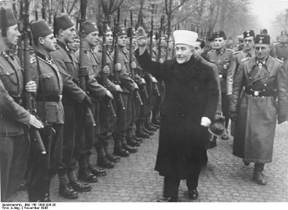
Mufti and his fez-wearing Nazi troops
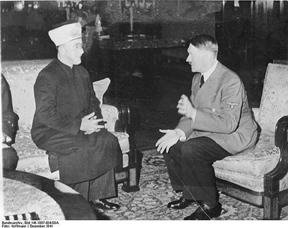
Mufti meeting Hitler
Unfortunately, Palestinian calls for murdering the Jews are found not just in history books – the present Palestinian Mufti, Muhammad Hussein, recently said at a Fatah event:
The Hour [of Resurrection] will not come until you fight the Jews. The Jew will hide behind stones or trees. Then the stones or trees will call: ‘Oh Muslim, servant of Allah, there is a Jew behind me, come and kill him. (From Palestinian Media Watch, Jan 15, 2012)
And while introducing the Mufti, the moderator referred to Jews as the “descendants of apes and pigs”:
Our war with the descendants of the apes and pigs (i.e., Jews) is a war of religion and faith.
So which leaders can be accused of supporting ethnic cleansing, racism and apartheid? Ben-Gurion, who spoke of living side by side with the Arabs, or Azzam Pasha, the Grand Mufti, and their modern successors, with their promises to massacre the Jews?
Which side – the Jewish or the Arab – aimed to commit genocide and to create an apartheid state? And why therefore, does the BDS movement target, of all countries, Israel?
Other false charges in the Ethnic Cleansing fact sheet
Myth: According to the Ethnic Cleansing of Palestine fact sheet, the war launched against Israel by 5 Arab armies was actually a land grab by Israel :
The 1948 Arab-Israeli War … resulted in a land grab by Israel, which expropriated considerably more land than had been apportioned to it under the partition.
Fact: Of course, as mentioned above, there would have been no war had the Palestinians and the Arabs accepted the United Nations partition resolution, instead of defying it and violating the UN Charter by attacking Israel. As for Israel “expropriat[ing] considerably more land than had been apportioned to it under the partition,” it’s ludicrous to complain about Israel supposedly not following the partition plan when it was the Arab side that rejected partition, and tried to prevent it by launching a genocidal war in which they killed fully one percent of the Jewish population.
Myth: The fact sheet also makes false claims regarding the number of Palestinian refugees:
In 1948, after the 1947 War, approximately 700,000 Palestinian Arabs fled to outer Palestine, from Jaffa, Haifa and West Jerusalem to Gaza and the West Bank, or to other countries such as Jordan, Lebanon and Egypt in four distinct waves.
Fact: This claim vastly overstates the number of Palestinian refugees. Census data just before the war for the number of Arabs in the part of the Palestine Mandate territory that became Israel, and census data after the war for the number of Arabs in the same territory, shows that the upper limit for the number of Palestinian refugees is about 539,000. (Walter Pinner, PhD, How Many Arab Refugees, p 28; Efraim Karsh arrives at similar numbers: How Many Palestinian Arab Refugees Were There?, Israel Affairs, April 2011)
And, entirely ignored by this and other apartheid web sites is the fact that there were more Jewish refugees from the Arab world than there were Palestinian refugees from Israel. These Jews, many of whom were able to trace their roots in the Arab world to the time prior to the advent of Islam, numbered more than 800,000, and were driven from the Arab countries during and after the war. About 600,000 of them came to Israel, many living in refugee camps before being resettled. For details see Jewish Refugees from Arab Countries: The Case for Rights and Redress and The Forgotten Narrative: Jewish Refugees from Arab Countries.
Pictured below is one of the refugee camps near Tel Aviv, set up to care for the Jewish refugees:
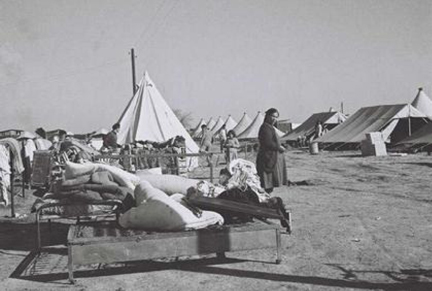
And pictured here is a refugee camp set up for Jewish refugees who were driven out of Jaffa by Arab forces (March 1, 1948):
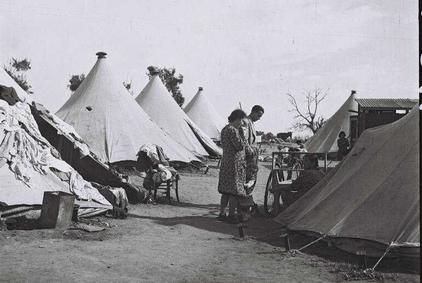
Myth: The fact sheet also vastly overstates the present number of Palestinian refugees:
Current estimates put the Palestinian refugee count at 6 million people. Some of these reside in Gaza, the West Bank, Jordan, Lebanon and Syria.
Fact: As of January 1, 2011 the number of registered refugees was 4,966,664 – that is, 20% less than what the fact sheet claims (according to data from UNRWA , the United Nations Relief and Works Agency for Palestine).
Moreover, even UNRWA’s figures are notoriously overstated, first of all because of the organization’s curious definition of who qualifies to be considered a Palestinian refugee. According to the UNRWA website (the link to the paragraph below from 2002 no longer works, but here is a link to a similar UNRWA statement):
Under UNRWA’s operational definition, Palestine refugees are persons whose normal place of residence was Palestine between June 1946 and May 1948, who lost both their homes and means of livelihood as a result of the 1948 Arab-Israeli conflict. UNRWA’s services are available to all those living in its area of operations who meet this definition, who are registered with the Agency and who need assistance. UNRWA’s definition of a refugee also covers the descendants of persons who became refugees in 1948. The number of registered Palestine refugees has subsequently grown from 914,000 in 1950 to more than four million in 2002, and continues to rise due to natural population growth. (emphasis added)
There are serious problems with considering descendants of refugees to be refugees themselves. Indeed, if one follows this definition, then the 600,000 Jewish refugees from Arab countries who came to Israel after 1948 were nonetheless still refugees even after receiving Israeli citizenship, as are all their descendants (since, in these claims, descendants of Palestinian refugees are themselves considered refugees, even if they have acquired citizenship, such as Palestinian refugees in Jordan). That is, there would be in Israel today around 3 million Jewish refugees from Arab countries.
In addition, the UN definition contradicts international law, under which descendants of refugees are not considered to be refugees. Thus, under the 1951 Convention Relating to the Status of Refugees, a refugee is a person who:
owing to well-founded fear of being persecuted for reasons of race, religion, nationality, membership of a particular social group or political opinion, is outside the country of his nationality and is unable, or owing to such fear, is unwilling to avail himself of the protection of that country; or who, not having a nationality and being outside the country of his former habitual residence as a result of such events, is unable or, owing to such fear, is unwilling to return to it.
There is no room under this definition for a descendant of a refugee to be considered a refugee. The UN got around this problem by creating a loophole – the usual refugee conventions do not apply to people receiving aid from UNRWA (and only Palestinians receive aid from UNRWA).
Whatever the definition, are the UN figures for the number of Palestinian refugees accurate, or are they likely to be overstated?
The answer is they are overstated, as the UN itself has admitted. For example, in the Report of the Commissioner-General of the United Nations Relief and Works Agency for Palestine Refugees in the Near East – 1 July 1997 – 30 June 1998, the UN concedes that:
UNRWA registration figures are based on information voluntarily supplied by refugees primarily for the purpose of obtaining access to Agency services, and hence cannot be considered statistically valid demographic data; the number of registered refugees present in the Agency’s area of operations is almost certainly less that the population recorded.
Since the refugee figures are based on “voluntarily supplied” information given for the purpose of obtaining services, such as financial aid and food rations, there is obvious incentive for people to falsely claim to be refugees. Especially since according to the UNRWA definition refugees don’t actually have to live in refugee camps.
There is also incentive never to report deaths of people considered to be refugees – since the rations for the deceased would be discontinued.
The results are predictable: sacks of rice and flour with the UNRWA logo are resold everyday by merchants in Arab marketplaces in, for example, Jerusalem and Gaza.
Myth: The fact sheet also falsely claims that UNGA Resolution 194 establishes for Palestinians a “right of return” to Israel:
Since 1948, the World Community has recognized the Right of Return to Palestine under the U.N. Resolution 194.
Fact: It is not clear how and when the “World Community” recognized such a “right.” But it is clear that Resolution 194 itself offers no support for such claims. In fact, the central provision of the resolution called for the creation of a Conciliation Commission and:
… establishment of contact between the parties themselves and the Commission at the earliest possible date … to seek agreement by negotiations [and thereby reach] a final settlement of all questions between them. (paragraphs 4 and 5)
That commission was duly formed, and convened in Lausanne, Switzerland, where the Arabs refused even to meet with the Israelis, much less to negotiate peace, a stance that was maintained through many years and multiple costly wars. The only clause of Resolution 194 the Arab side ever acknowledged was paragraph 11, which suggested (it could not “require,” since it was a General Assembly rather than a Security Council resolution) that:
refugees wishing to return to their homes and live at peace with their neighbors should be permitted to do so at the earliest practicable date … [R]epatriation, resettlement and econ
omic and social rehabilitation of refugees and payment of compensation [should be facilitated]. (emphasis added)
Even if this were a Security Council resolution, because it only recommends (“should”) that refugees be permitted to return, it can hardly be characterized as creating a “right.” Moreover, the requirement that returnees first accept living “at peace with their neighbors” meant that Palestinian returnees would have to accept Israel’s right to exist, something that very few of them, even today, seem truly willing to do. Further, it did not even hint at any return rights for descendants of refugees.
All the Arab states voted against Resolution 194, precisely because it did not establish a “right of return,” and because it implicitly recognized Israel (for the voting results see UNBISNET). It is disingenuous, at best, for those same Arab states (and Palestinian representatives) to see today in Resolution 194 the right of return they formerly claimed did not exist.
Additionally, even if Resolution 194 had been legally binding in 1948, it would have lost any such weight under the fundamental legal principle of estoppel. Under this quite reasonable precept, a party who materially violates a contract or agreement is barred from asking the other parties to live up to their obligations under the same contract. The Arab side, having rejected and violated Resolution 194 from the day of its inception, cannot now come to Israel and say “Implement Paragraph 11.”
Myth: Israel is “Judaizing” the city of Jaffa:
Jaffa is yet another city that has been settled by Israelis pushing Arabs out of the community by slowly “Judaizing” the Old City and confiscating land and homes.
Fact: In fact, far from being pushed out of Jaffa (which is part of the larger city of Tel-Aviv), the Arab population of Jaffa is growing rapidly. According to the 2009 Statistical Yearbook for the Tel-Aviv/Yafo Municipality (the latest available), here is how the city’s population groups grew from 2005 to 2008:
| 2005 | 2008 | Growth Rate | |
|---|---|---|---|
| Arab population in Jaffa | 14,500 | 15,500 | 6.9% |
| Arab population in Tel-Aviv | 15,900 | 17,300 | 8.8% |
| Jewish population in Tel-Aviv | 347,800 | 358,600 | 3.1% |
Based on Table 2.21 Tel-Aviv/Yafo Municipality Statistical Yearbook No. 48, 2009 | |||
That is, the Arab population in Jaffa, and the Arab population in Tel-Aviv as a whole, both grew at well more than double the pace of the Jewish population in the city. Some ethnic cleansing, some apartheid.
The bottom line: charges by the BDS movement of Israeli ethnic cleansing are baseless propaganda, pure and simple.
The Settler-Only or Jewish-Only Road Charge
Myth: According to Israeli Apartheid in the Occupied Territories:
Palestinians are prohibited from using the extensive network of settler only highways that connect the settlements to Israel.
Fact: In fact, this charge of what could be called “road apartheid” is false – there are no “settler-only” (or “Jewish-only,” as other sources often charge) roads. However, since the explosion of violence that began with the first intifadah, which included deadly attacks on civilian Israeli cars, there are roads that have for security reasons been restricted to Israelis only. Israeli Jews, not just settlers, use these roads, as do Israeli Arabs, often on visits to relatives in the West Bank (for an example of news outlets correcting false claims about “Jewish-only” roads see here). Since the restrictions on the roads are based on nationality – and not religion or ethnicity – labeling this apartheid is clearly fallacious.
However, while Israel has no Jewish-only or settler-only roads, there are roads in the Middle East that are restricted to members of certain privileged religious groups.
For example, there are Muslim-only roads in Saudi Arabia, and only Muslims are allowed to even set foot in Mecca and Medina and the surrounding areas known as the Hejaz. See for example, the Saudi Embassy website, which on the Traveler’s Information page helpfully states that:
Makkah and Madinah hold special religious significance and only persons of the Islamic faith are allowed entry.
Here, in Arabic and English, are two of the Saudi highway signs openly enforcing this apartheid and discriminatory policy:
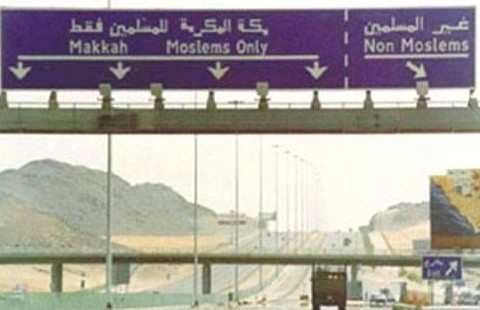
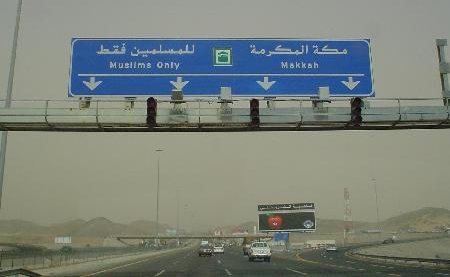
So Mecca, the holiest city for Muslims, is a closed city, for Muslims only. In contrast, Jerusalem, the holiest city for Jews, is an open city, with Muslim, Christian and Jewish residents, and around one million tourists of all faiths visiting every year.
Of course, restrictions on visiting Mecca and Medina are only the tip of the iceberg, and there are many other discriminatory and racist policies in Saudi Arabia and in the Middle East more general
ly, including in the PA, and in Gaza under Hamas. So why isn’t the BDS movement targeting Saudi Arabia and the Palestinian Authority, and calling for sanctions on those governments?
Looking at the region as a whole, Israel is a small island of freedom in a sea of dictatorships, as illustrated in this map adapted from Freedom House’s annual survey Freedom in the World 2010:
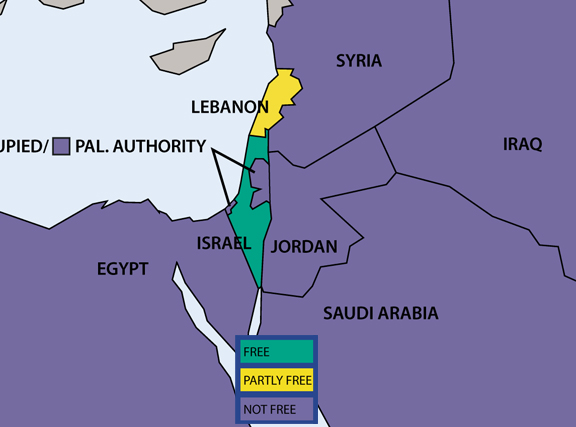
Yet the BDS movement is silent about abuses against Arabs in Arab countries, and targets only Israel.
• Charges regarding water
Myth: Both in the overview and in the fact sheet Water as an instrument of Apartheid in the Occupied Territories, Israel is charged with water apartheid. According to the overview, Israeli Apartheid in the Occupied Territories:
The Israeli military authority controls virtually all the water in the West Bank. 73% of West Bank water is piped back to Israel. Illegal Jewish settlers use 10% of West Bank water.
Fact: First of all, the citation given to support these charges – a report by the Israeli organization B’Tselem – actually says nothing of the sort. Nowhere in the report, for example, does it say or imply that “73% of West Bank water is piped back to Israel,” or that any water from the West Bank is piped back to Israel.
The fact sheet Water as an instrument of Apartheid in the Occupied Territories repeats a similar charge, this time with a citation that at least seems to offer support for the charges:
Control of the occupied territories by Israel is all about the control of water and other resources. Israel controls all of the water in the West Bank including aquifers under Palestinian territory and currently 83% is piped to Israel or used in the settlements, which is illegal under international law…
The facts, however, clearly contradict this charge. Israel does not take “Palestinian water,” and no water is piped from the West Bank into Israel. Israel obtains roughly 50 percent of its water from the Sea of Galilee and the Coastal Aquifer, both of which are entirely within Israel’s pre-1967 lines. Another 30 percent comes from the Western and Northeastern Aquifers of the Mountain Aquifer system. These aquifers straddle the Green Line separating Israel from the West Bank, but most of the stored water is under pre-1967 Israel, making it easily accessible only in Israel.
The reason the water is mostly under Israel, and accessible there, is easily understood: Israel, with a Mediterranean coastline (that is, at sea level), is at a lower elevation than the West Bank, and under gravity the underground water flows down to the lowest point, which is Israel. For the same reason, the aquifer is much closer to the surface in Israel, and therefore more accessible there, than in the higher elevations of the West Bank.
Thus, even in the 1950s, when the West Bank was occupied by Jordan, Israel used 95 percent of the Western Aquifer’s water, and 82 percent of the Northeastern Aquifer’s water. Today, Israel’s share of these aquifers has declined to 83 percent and 80 percent, respectively. That is, under direct Israeli administration the Palestinian share of these aquifers has actually increased.
It is therefore simply ludicrous to claim that Israel’s use of this water (which began in the 1920’s during the pre-state era) is “illegal under international law.”
In addition, every year over 40 MCM (million cubic meters) of water from sources within Israel is piped over the Green Line for Palestinian use in the West Bank. Ramallah, for example, receives over 10 MCM annually. And despite the virtual declaration of war against Israel by the Hamas rulers of Gaza, Israel still sends to Gaza over 4 MCM of Israeli water annually. Thus, it is the Palestinians who are using Israeli water.
And not just the Palestinians. Despite its own meager supply, Israel annually provided 600,000 CM of water to ten otherwise dry villages in South Lebanon, and under its peace treaty with Jordan provides more than 55 MCM annually to the Kingdom. Perhaps no other country in the world, facing the severe shortages that Israel does, has shared so much water with its neighbors.
To summarize, the “apartheid” water charges could not be more false. Israeli water, drilled in Israel, is piped over the Green Line into the West Bank for Palestinian use, and therefore it is the Palestinians who are using Israeli water. More details are available here, here and here.
Other Fallacious Water Charges
Myth: There are many other false charges in the water “fact sheet,” for example:
Palestinians had more water available per person before the 1967 invasion and occupation of the West bank and Gaza than they do now.
Fact: This charge is a vast inversion of reality. In fact, in the period from 1967 to 1995 West Bank Palestinians increased their domestic water use (ie, home use) by 640%, from 5.4 MCM to 40 MCM (Judea-Samaria and the Gaza District – A 16 Year Survey 1967 – 1983, Israel, Ministry of Defense, 1983; Arnon Soffer, The Israeli Palestinian Conflict over Water Resources, Palestine-Israel Journal, Volume 5, No. 1, 1998). By way of comparison, in the same 28 year period Israeli domestic usage increased by just 142% (Statistical Abstract of Israel 1996, V47)
Total use (domestic, industrial and agricultural) also increased: In 1967 total Palestinian usage in the West Bank was 60 MCM, amounting to a per capita annual usage of 85.7 CM, while in 2006 total usage had tripled to 180 MCM, amounting to a per capita annual usage of 100 CM (see The Issue of Water between Israel and the Palestinians, Israel Water Authority, 2009; p 15)
This huge jump in Palestinian consumption was possible only because Israel drilled or permitted the drilling of over 50 new wells for the Palestinian population, laid hundreds of kilometers of new water mains and connected hundreds of Palestinian villages and towns to the newly built water system, and supplied Israeli water to the Palestinians through this new system. (Background: Water, Israel and the Middle East, Israel Foreign Ministry 1991; Marcia Drezon-Tepler, Contested Waters and the Prospects for Arab-Israeli Peace, Middle Eastern Studies, Vol 30, No. 2, April 1994)
Palestinian sources broadly confirm this picture. For example, Taher Nassereddin, Director General of the West Bank Water Department, has stated that:
[Palestinian] consumption for domestic purposes has increased as a result of population growth and that there were no severe restrictions on drilling new wells for these purposes. (Taher Nassereddin, Legal and Administrative Responsibility of Domestic Water Supply to the Palestinians, in Joint Management of Shared Aquifers, 1997)
It is important to note, however, that for political reasons some Palestinian villages and towns refused to be hooked up to the new Israeli-built water system, and they therefore may not have a reliable water supply today. Thus, as reported in Audubon Magazine, the West Bank town of Marda:
… like many West Bank villages and towns, had refused to hook up with the Israeli water system in the early 1980’s, when Israeli officials offered them the chance. Doing so, the politicians felt, would legitimize the Israeli occupation. Even the villages that did hook up refused to pay into the Israeli water fund that subsidizes the system’s costs. As a result, Palestinians now pay as much as three times what Israelis pay for water. (Bruce Stutz, Water and Peace, Audubon, September 1994)
The price of water for Palestinians and Israelis
Myth: According to Israeli Apartheid in the Occupied Territories Palestinians must buy water from Israel “at 4 times the price Israelis pay.” Similarly, Water as an instrument of Apartheid in the Occupied Territories charges that:
Israel often sells the water it appropriates from the West Bank back to the Palestinians at inflated prices. [Palestinians pay four times the rate charged to Israelis].
Fact: Of course, Israel is not “appropriating” water from the West Bank, the opposite is true. And while it is the case, as indicated in the previous section, that Palestinian municipalities which agreed to be connected to the Israeli water system refused to contribute to the subsidy fund and therefore pay a higher cost for bulk water, it is not true that Palestinian consumers pay more for water than do Israeli consumers. This is because Israeli municipalities impose a far greater markup on the bulk water they purchase from the Israeli water company than do their Palestinian counterparts, leaving the net cost roughly equal. In some cases, however, Israeli consumers have paid more than Palestinian consumers for the same quantity of water.
Look at prices in 1995 for example, since this was roughly the period that the Palestinian Authority gained responsibility for supplying water to Palestinian towns and villages. The following rate schedule (in New Israeli Shekels) was in effect in Israel for domestic water used by consumers (Jerusalem Post, June 9, 1995):
| 2.07 NIS per CM 3.10 NIS per CM 4.57 NIS per CM |
In addition there was a .12 NIS per CM surcharge for pipe maintenance.
So an Israeli using 24 CM in the billing period would have been charged 79.39 NIS for water plus 2.88 NIS for the surcharge, for a total cost of 82.27 NIS, or $27.41 (at the 1995 exchange rate of 3.0013 NIS per dollar, Israel Yearbook and Almanac 1996, p 153).
Meanwhile, a Palestinian in Ramallah (which is serviced by a Palestinian utility called the Jerusalem Water Undertaking) would have been subject to a 1995 rate schedule of (JWU Annual Report for 1995):
| $12.66 flat fee $1.00 per CM $1.05 per CM $1.50 per CM |
Thus for 24 CM the Palestinian consumer would have paid $26.86 – that is, 55 cents less than the Israeli consumer paid for the same amount of water.
Indeed, according to Sharif Elmusa, who was a water negotiator for the Palestinian side in talks with Israel, Palestinians in the West Bank pay approximately $1 per CM for domestic water, “virtually identical with the price in Israel …” (Elmusa, Water Conflict, p 144)
Similarly, with regard to agricultural water, Elmusa writes “ … in absolute terms, the price of irrigation water in Israel, the West Bank, and Jordan converged, and water prices could not have affected competitiveness in any significant way.” (Elmusa, p 173)
Finally, it should be noted that according to Elmusa, some West Bank towns charged substantially less for water than did Ramallah. For example, per cubic meter of water, consumers in Jericho paid just one quarter what was paid in Ramallah, while consumers in Tulkarem paid one third the Ramallah price. In other words, Palestinian consumers in Jericho and Tulkarem paid substantially less for water than did consumers in Ramallah or Israel.
• The Minimum Wage Charge
Myth: According to Israeli Apartheid in the Occupied Territories:
Palestinian workers employed in settlement industrial zones receive only the sweatshop-like minimum wage mandated by Jordanian law in 1967. In the settlements, Israeli workers receive all the rights and benefits of Israeli employment law including a much larger minimum-wage.
Fact: This charge is both confused and false. And once again, the reference cited to support the charge, in this case a blog article (!), does not actually say anything of the sort. ( It is notable that the blog also includes a 911 truther article questioning what really happened to the Twin Towers on 911.) The choice of such an unreliable source, and the fact that the source again offers no support for the charge, raises further questions about the credibility of those casting the apartheid accusation at Israel.
Here are the facts: Under international law (specifically Article 43 of the Hague Regulations of 1907), upon taking control of the West Bank Israel was obligated to maintain, as much as possible, the existing laws:
The authority of the legitimate power having in fact passed into the hands of the occupant, the latter shall take all the measures in his power to restore, and ensure, as far as possible, public order and safety, while respecting, unless absolutely prevented, the laws in force in the country.
This would include of course, the existing West Bank labor laws, in this case the Jordanian Labor Law 21-1960 as amended by Labor Amendment Law 2-1965 (see for example Tobias Kelly, “Jurisdictional Politics” in the Occupied West Bank, Law and Social Inquiry, 2006; p59, footnote 29). Under these laws there was no minimum wage whatsoever. So the charge against Israel is first of all wrong in that there was not a “sweatshop-like minimum wage [that was] mandated by Jordanian law in 1967.”
More importantly, Israel added to the labor law through a series of Military Orders, beginning in 1976 with Military Order 663, which specified compensation payments for workers in the West Bank. In 1982 Military Order 967 was promulgated, which “applied a different standard of labor law to Palestinian workers working in Jewish settlements than those in force in the rest of the West Bank.” In 1987 there was a further change to the West Bank labor law through another Military Order:
Military Order 1198
19 November 1987Order Concerning Employment of Workers in Specified Places
… it is the right of a worker in a settlement to receive from his employer a wage which is not below the minimum wage including a cost of living allowance identical to that which is granted in Israel. (Israeli Military Orders as listed in the JMCC collection Israeli Military Orders in the Occupied Palestinian West Bank, 1967-1992)
In other words, as the number of Palestinians working in Israeli settlements grew, the government started to amend and improve the existing labor laws, eventually explicitly requiring, more than 24 years ago, the same minimum wage as in Israel.
Because some employers, including Palestinian contractors, violated this order, Palestinian workers filed a lawsuit that eventually reached the Israeli Supreme Court. On October 10, 2007 the court, sitting as the High Court of Justice, ruled in favor of the Palestinian workers. As reported in Ha’aretz:
Israeli labor laws will be applied to Palestinians working in West Bank settlements, the High Court of Justice decided yesterday in a precedent-setting ruling. A panel of nine justices ruled on a petition submitted by Kav LaOved Worker’s Hotline, and two Palestinians working for Israeli employers in the West Bank. The Palestinian petitioners worked for the local council of Givat Ze’ev and various private companies, and demanded the rights extended to workers in Israel, including minimum wage, severance pay and various social benefits.
So since 1987 under a Military Order, and since 2007 as a matter of Israeli civil law, Palestinian workers in Israeli settlements are covered under Israeli minimum wage and other labor standards. The minimum wage apartheid charge is therefore entirely baseless.
There is something else worth noting here – despite not being citizens of Israel, Palestinians from the West Bank who have grievances against Israel or against Israelis can file suits in Israeli courts, including the Supreme Court, and quite often they win.
This is what the BDS movement labels as Israeli apartheid?
Finally, it should also be noted that most Palestinian workers don’t work for Israeli enterprises, and are therefore covered by the Palestinian Authority’s labor laws. And under the PA there is still no minimum wage. That’s because under Yasir Arafat’s Presidential Decree No. 1 all Israeli military orders were canceled in the Palestinian controlled territories, and the laws reverted to what they were before the beginning of Israeli rule. Which meant, in particular, that the old Jordanian Labor Law, without any minimum wage, was back in effect (see the US State Department Country Reports on Human Rights for 1999 for the situation in those years).
In 2001 a Palestinian Labor Law ( Labor and Laborers Law 4-2001) replaced the Jordanian law, but under this new law there is still no minimum wage, as confirmed by the the 2008 Country Report on Human Rights, which states in its section on the Palestinian territories that:
There was no minimum wage. Prior to 2000, average wages for full-time workers provided a decent living standard; however, living standards dropped significantly over the past eight years due to increases in cost of living which outpaced salary increases.
It is ironic that contrary to those who accuse Israel of apartheid practices, it is only under Palestinian rule that Palestinian workers fail to be protected by a minimum wage.
Alleged Apartheid within Israel
There are at least two separate fact sheets dealing with alleged apartheid within Israel: Apartheid and Discrimination in the State of Israel and Discriminatory Laws in the State of Israel. Somewhat confusingly,. there is also a PDF version of the first fact sheet with a
slightly different title, and somewhat different content: Apartheid and Discrimination inside the State of Israel.
Myth: As with the other fact sheets, the Apartheid and Discrimination fact sheet is filled with blatant falsehoods and distortions. For example, it includes Israel’s Law of Return in a listing of supposedly apartheid laws:
Beginning with the rights of residence and citizenship, the Law of Return grants immigrant and residency rights to anyone who claims a Jewish identity (defined as a child or grandchild of a Jew, the spouse of a Jew, the spouse of a child of a Jew, and the spouse of a grandchild of a Jew) but refuses the right of return to Palestinians and their descendants who were expelled in 1948.
Fact: The Law of Return is neither racist not peculiarly Israeli. Similar laws have been in effect in such democracies as Mexico, Ireland, Finland, Greece, Poland, Germany, Italy, and Denmark. Furthermore, such laws are expressly permitted by, for example, the International Convention on the Elimination of all Forms of Racial Discrimination (1965). According to Article 1(3) of this convention, nations are permitted to favor certain groups for citizenship provided there is no discrimination against any particular group.
Furthermore, Article 1(4) provides for “affirmative action.” That is, a state may employ a preference in granting citizenship to undo the effects of prior discrimination. In the case of Israel such prior episodes of discrimination are clear: the British decision in 1939, for example, to bar Jewish immigration to Mandatory Palestine, thereby consigning millions of Jews to deaths in the crematoria of Europe. To an exceedingly small degree, the Law of Return helps to mitigate this wrong.
As stated above, other democracies have similar laws. For example, in Ireland the the appropriate minister can waive the usual requirements for citizenship under various conditions including:
Where the person is of Irish descent or of Irish associations, or is a parent or guardian applying on behalf of a minor child of Irish descent or Irish associations.
The text of the full Irish law makes clear just how widely the concept of descent or associations is defined:
Section 16 of the Principal Act is amended by the insertion of the following subsection:
‘‘(2) For the purposes of this section a person is of Irish associations if—
(a) he or she is related by blood, affinity or adoption to a person who is an Irish citizen or entitled to be an Irish citizen, or
(b) he or she was related by blood, affinity or adoption to a person who is deceased and who, at the time of his or her death, was an Irish citizen or entitled to be an Irish citizen.’’
The Irish “law of return” is therefore even more expansive than Israel’s, as it does not cut off at the level of the grandparent. Would those who accuse Israel over its Law of Return charge that Ireland, Greece, Poland, Finland, Germany and Denmark are also apartheid states?
Myth: The high percentage of prisoners in Israeli jails who are Palestinian is another instance the fact sheet cites of alleged Israeli discrimination :
70% of prisoners in Israel are Palestinian.
Fact: In fact, the percentage of Palestinians and Israeli Arabs in Israeli jails is 60%, not 70%, according to data collected from the Israeli Prison Service by the very anti-Israel organization Adalah (12,990 out of 22,000).
But, of course, that hardly tells the whole story, since many of the Palestinians in Israeli jails are there because of the explosion of Palestinian violence since the signing of the Oslo Accords with Yasir Arafat and the PLO in 1993. Since that time a total of 1469 Israelis were killed and more than 10,000 were wounded in Palestinian terror attacks (see here, here and here for details).
With over 14,000 killed or wounded in Palestinian attacks, it seems reasonable that there would be quite a few Palestinians in Israeli jails. Likewise, the claim that this is evidence of discrimination against Palestinians is silly. In fact, the large number of Israelis killed or wounded by Palestinians would point to anti-Israeli discrimination by Palestinians.
Moreover, one could ask, what are the rates of imprisonment since the wave of Palestinian violence ebbed? One would expect, in a fair and honest system of justice, that the rate of imprisoning Palestinians would decline accordingly, and this is exactly what happened.
According to the Statistical Abstract of Israel, for the year 2009 (Table 11.4), Jews represented 64.4% of the total imprisoned:
| Jews | Arabs |
| 6872 | 3799 |
Other recent years were similar, proving that the fact sheet claim is totally false. It should also be noted that the claim is footnoted, but neither of the articles cited in the footnote offer any support for the claim, which is a further deception.
Myth: Before 1948 Arabs owned most of the land in Israel, which the Jews proceeded to steal:
In 1945, Palestinians owned 85% of arable land. The U.N. Conciliation Commission estimated that about 80 percent of the land in what is today Israel is property formerly owned by Palestinians that was confiscated by Jewish organiza
tions like the Jewish Agency. Until recently Palestinians were forbidden by Israeli law from owning it or leasing it.
Fact: It is true that the cited reference, Progress Report of the United Nations Conciliation Commission for Palestine (A/1985 20 November 1951) does make roughly this claim at one point, though concerning total land, not “arable land”:
36. The Office estimated that the extent of the land abandoned by Arab refugees is 16,324 square kilometres, of which 4,574 square kilometres are cultivable.
Since Israel’s total land area is approximately 20,250 square kilometers, the claimed Arab holding would be approximately 81% of the country’s land area. However, this number is absurdly large when compared with data from British surveys during the Palestine Mandate, which showed that the vast majority of the country’s land was state land, belonging neither to Jews nor Arabs, but to the sovereign. It is no surprise, therefore, that elsewhere in the report much more realistic figures are given. Specifically, Appendix 1, Paragraph 15, presents a table on the “total extent of abandoned Arab land”:
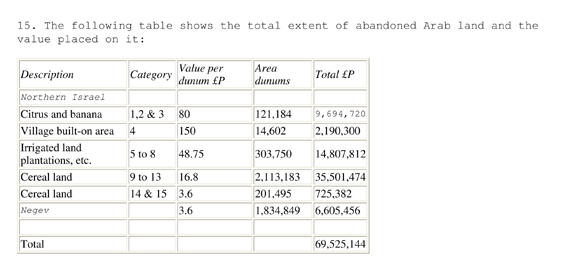
Now, considering that 1000 dunams equals a square kilometer, the table shows that total Arab holdings amounted to just 4,589 square kilometers, which would be about 23%, rather than 80%, of the country. But even this is an overstatement, since the vast majority of the Negev was so-called “mewat” land under the Ottoman Land Code, and therefore state land rather than privately held land. Subtracting out the alleged Negev holdings would leave 2,754 square kilometers as the total of privately-held Arab land, or approximately 14% of the country. By way of comparison, the total of privately-held Jewish land prior to the war was approximately 8.6%. The bottom line is that the claim that Arabs had owned more than 80% of the country is a vast overstatement.
Myth: Regarding land, the fact sheet also charges that:
Today, Israeli Palestinians are largely landless — they own about 3% of the land in Israel. Since 1948, the Arab population has increased by a factor of 6.6 but it has lost 84% of its land reserves. As of 1947, Jews in Palestine owned under 7% of the Palestinian lands, and after the 1948 war, 80%.
The related fact sheet, Discriminatory Laws in the State of Israel, levels a similar charge:
… Israel has managed to prohibit non-Jewish [i.e., Palestinian] citizens from acquiring land or leasing land, including land taken from them under various statutes… 93% of the land in Israel has this prohibition.
Fact: It is true that Arabs own about 3.5% of the land in Israel – but this amounts to half of the private land in the country, meaning that Arabs, who are about 20% of the population, own a disproportionately large share of the land; Jews, who are almost 80% of the population, own the other 3.5%. The disproportionately large share of private land held by Arabs is therefore hardly a sign of discrimination.
Though land privatization is underway in Israel, about 80% of the land in the country is owned by the state, and another 13% is owned by a private NGO known as the Jewish National Fund, or JNF. This will change as the land is sold to private individuals and companies, but for now, with JNF land still managed by the state, 93% of the land in Israel is owned or controlled by the government. The state-owned land is available for lease to individuals and companies, both Arab and Jewish, and is also used for public purposes, such as roads or parks, that are used by both populations.
The claims that Arabs are “landless” and have no access to state land, and that after the war Jewish ownership of land jumped to 80%, are therefore, once again, baseless. For more details see here and here. Finally, even those Arabs from East Jerusalem who have not chosen to accept Israeli citizenship and therefore have the status of permanent resident are also eligible to lease state land, and to buy or lease apartments on state land.
Myth: The higher infant mortality among Arab citizens of Israel, and the growing gap as compared to Jewish citizens, is yet another example of the country’s discriminatory policies:
Infant mortality rates among Arabs are twice those among Jews. The gap has existed since the establishment of the state and has grown over the years.
Fact: The infant mortality rate in Israel among Arabs is higher than it is for Jews, but the rate for Arab Christians is similar to that for Jews, and in some recent years actually lower than for Jews. This shows quite clearly that alleged anti-Arab discrimination is not the reason for the higher infant mortality rate for Israeli Arab Muslims. And rather than the gap growing over the years, the opposite is true – the gap has declined tremendously, thanks to intensive efforts by the Israeli health authorities. The following table from Israel’s Central Bureau of Statistics shows the impressive results:
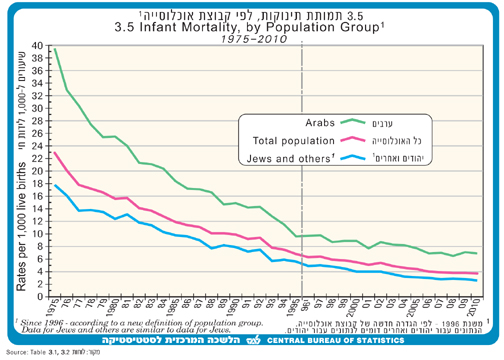
The average infant-mortality rates in the period 2001-2004 and the rates in 2010, for Jews, Arab Christians, Arab Muslims and Arab Druzes, break down as follows: (Sources: Statistical Abstract of Israel 2011, Table 3.1 and Infant Mortality 1997-2004 Demographic and Health Characteristics, Table 2, p 62)
| Jews | Arab Christians | Arab Muslims | Druze | |
| 2001-2004 | 3.6 | 3.1 | 8.6 | 5.9 |
| 2010 | 2.7 | 2.8 | 7.3 | 3.2 |
Among the reasons for the higher rate among Arab Muslims are the following known risk factors for infant mortality: (1) motherhood at a very early age tending to lead to low-birth-weight babies; (2) large families – almost 24% of Arab households in Israel contain 7 or more people, and a further 16% contain 6 people, while for Jews the corresponding numbers are just 8.3% and 5.7%; (3) marriage among close relatives , leading to birth defects.
Finally, to place the infant mortality numbers in context, one should note that in 2007 the rate in the United States was 6.8 (Statistical Abstract of the United States 2012), far higher than the rate in Israel for Jews, and Arab Christians and Druze, and not that different from the rate among Arab Muslims.
In other words, the infant mortality charges are baseless, and under scrutiny fall apart.
As mentioned above, the Discriminatory Laws in the State of Israel fact sheet also levels a series of wildly inaccurate charges.
Myth: Israel’s lack of a constitution is another sign of its anti-Arab policies:
The founding of Israel required a constitution guaranteeing basic rights for all its citizens. Israel still has no constitution.
Fact: First, of all, it is not up to BDS proponents to decide what is “required” of Israel – who appointed them judge and jury? Moreover, they must count on their readers being unaware that Israel is a parliamentary democracy, and that its constitution is being created through the passage of specific “basic laws,” similar to the situation in Great Britain and in New Zealand, which also lack a founding constitution. Would those who accuse Israel because it wasn’t founded with a final constitution also say for this reason that Great Britain and New Zealand are apartheid states?
Myth: The fact sheet also charges that Palestinians (that is, Israeli Arabs) are forbidden from serving in the Israeli army:
Israeli Jews (except some orthodox Jews) have to serve in the Israeli army when they turn 18. Most Palestinians are forbidden to serve in the army. Many of the benefits of society are given to people who have served. Preferential treatment of housing, education and other services are given to army veterans.
Fact: No Israeli Arabs are barred from serving in the Israeli army – Druze Arab men are drafted into the army when they turn 18, just like most Israeli Jews (this is by consent of the Druze community). Moreover, a higher percentage of eligible Druze serve in the army than eligible Jews, and 60% of Druze recruits choose to serve in combat units.
Men from the Israeli Arab Bedouin community also routinely volunteer for the army, where they have served with special distinction as scouts and trackers. For instance, according to a recent BBC report:
… there are thousands of Muslim Bedouin who serve in the Israeli army, or IDF, and even bear arms against their fellow Muslims in the occupied West Bank and Gaza. They do so although it is not compulsory for them to serve in the Israeli military, as it is for most Israeli Jews, and sometimes military service comes with a price tag.
“I will do whatever is required from me to do the job with the full faith in the service of the Israeli state,” asserts Maj Fehd Fallah, a Bedouin from the village of Saad in the Israeli occupied Golan.
He is happy to perform his duty, whoever he may have to fight against.
Bedouin have fought and died alongside Jewish Israelis in the army “Yes, I have fought against Muslims in Gaza,” he says. That includes Israel’s three-week Operation Cast Lead which began in December last year.
“And I would fight again if I had to,” he added. “Israeli Muslims who don’t serve in the IDF should be ashamed for not serving their country.”
Other Israeli Arabs – both Christian and Muslim, including women – are also free to volunteer to serve in the Army.
For example, a recent article in ynet, the online version of the Israeli newspaper Yediot, told the story of Shirin Shlian, a young Arab woman from the Galilee, who is proudly serving in the IDF, and whose job “is to encourage high school students to enlist – and better yet, to join combat units.” She is not the only one of her family to serve – one brother is a major in a combat unit, and another served with the Border Guard. According to the article:
Shirin concludes, “I am very proud of my military service. I have always dreamed of joining the IDF and making a contribution to my country.” She says her boyfriend supports her decision to serve in the army as well.
Nazareth Illit Mayor Shimon Gapso has only good things to say about her: “Soldier Shirin serves as a positive example. There are many more like her in Nazareth Illit, a city which symbolizes coexistence between all of its parts.”
Another example is Elinor Joseph, a Christian Arab from Haifa, who in 2010 became the IDF’s first female Arab combat soldier:
 |
| Elinor Joseph, a Christian Arab and a combat soldier in the Israel Defense Forces, says that “At the end of the day, this will always be my home too.” |
The fact sheet’s claim that Arabs are prevented from serving in the Israeli army is thus yet another obvious falsehood.
Conclusion
Contrary to the extreme and malicious distortions of the Israeli apartheid campaigners, the progressive nature of Israeli society simply cannot be denied – an imperfect society to be sure, just like other democracies, but honestly striving to be better
.
In this regard, it’s worth mentioning that Israel’s next Ambassador to Ethiopia will be Belaynesh Zevadia, who immigrated to Israel from Ethiopia at the age of 17.
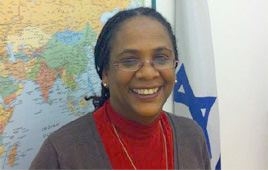
Reacting to the appointment, Zevadia said:
I am very proud to be appointed as ambassador, especially as the first Ethiopian Israeli ambassador. I immigrated to Israel as a teenager and I am returning to Ethiopia as an ambassador. It is a great honor for me and my family, and I would like to thank the Minister of Foreign Affairs, Avigdor Liberman, and the staff of the Foreign Ministry for the trust they are placing in me. This is proof that in Israel opportunity is available to everyone, native Israelis and new immigrants alike.
As the late New York Times columnist William Safire memorably wrote when Israel’s secret rescue of the Ethiopian Jews became public:
Israel’s example of conscience demonstrates that certain affinities can transcend bigotry – that religion can be a stronger force than racism…
For the first time in history, thousands of black people are being brought into a country not in chains but in dignity, not as slaves but as citizens…
Israel’s quiet acceptance of responsibility should say a great deal to Africa, to American blacks and Jews, and to all who believe that the ”Falashas” of the world should be strangers no more. (New York Times, January 7, 1985; emphasis added)
Whether based on alleged racial discrimination, ethnic cleansing, water theft, infant mortality rates, “Judaizing” of Jaffa, service in the army, or being barred from aquiring or accessing land, etc., the apartheid charges against Israel have been revealed to be baseless. The accusations are merely a pretext in the hands of those activists who – for whatever reason – are bound and determined to be anti-Israel, regardless of the facts.
